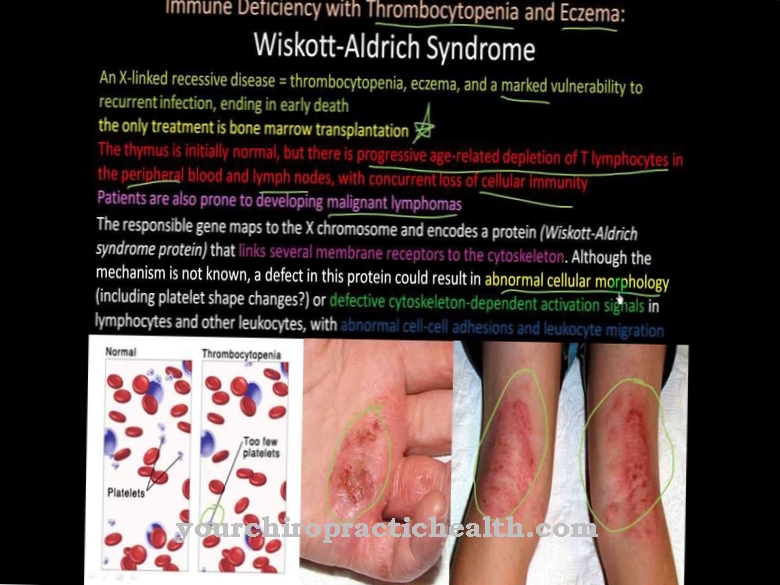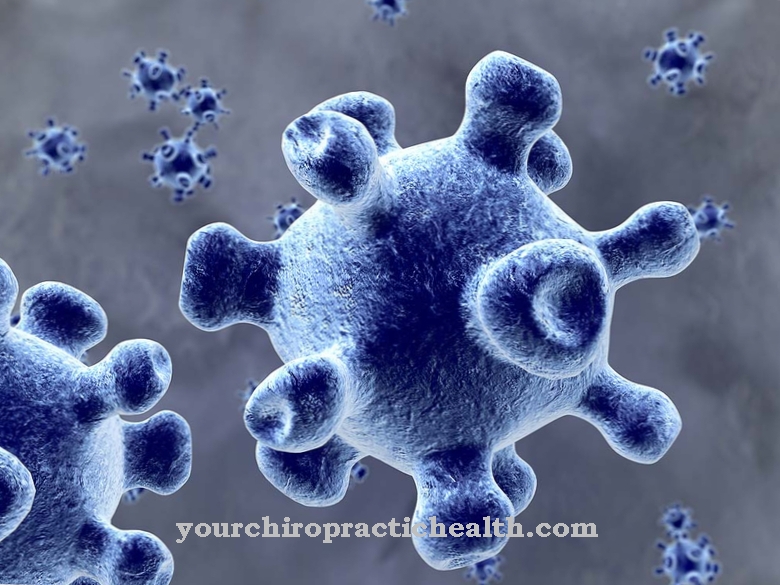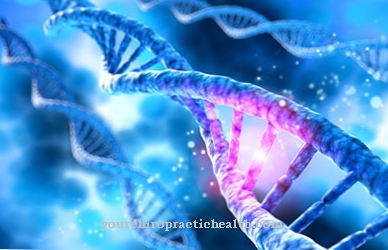The Crouzon's syndrome, also Crouzon's disease called, is one of several known, genetically caused craniosynostoses in which the cranial sutures ossify prematurely, so that the growth of the skull is disturbed and typical malformations and adhesions on the head and face can occur. The mental development of people affected by Crouzon syndrome is usually normal.
What is Crouzon's Syndrome?

© royaltystockphoto - stock.adobe.com
Crouzon's syndrome, too Craniofacial dysostosis Crouzon called, is one of several known craniosynostoses. The disease is characterized by early ossification of the cranial sutures, some of which begins prenatally. The ossification means that during its growth phase the brain cannot easily spread under the skullcap, which normally also "grows with the child". Instead, the skullcap grows mainly on the not yet ossified cranial sutures, so that if left untreated, typical malformations occur.
In Crouzon's syndrome, the coronary, alpha and sagittal sutures initially ossify. Without treatment or without corrective surgical interventions, a typical tower skull and facial anomalies such as excessive eye relief (hypertelorism) and protruding eyes (exophthalmos) occur. In addition to misalignment of the teeth, deafness must be expected in Crouzon's syndrome because the external auditory canal has an occlusion, an auditory canal atresia, and / or the ossicles are not fully developed, so that hearing impairment occurs.
causes
Crouzon's syndrome is caused exclusively by a mutation at the 10q26 gene locus on chromosome 10. There are around 1,200 genes on chromosome 10, which contain 4% to 4.5% of human cell DNA. The 10q26 gene is responsible for coding the “fibroblast growth factor receptor 2” (FGFR2). The effects of this specific gene mutation are differently pronounced within an observed range.
The gene mutation is inherited as an autosomal dominant trait. This means that Crouzon's syndrome is not gender-specific, so it can affect men and women equally, and it means that the disease will definitely occur even if only one parent is affected by the genetic defect at locus 10q26. The most noticeable effect of this genetic defect is the premature ossification of the skull sutures. The cranial sutures represent the growth plates of the bone plates of the frontal bone (Os frontale), parietal bone (Os parietale) and occipital bone (Os occipitale).
If the sutures become ossified during the growth phase, the skull cannot enlarge uniformly and the brain causes increasing growth pressure, which leads to the typical deformations of the skullcap.
Symptoms, ailments & signs
In addition to the particularly noticeable symptoms of Crouzon syndrome already described above, such as tower skull, protruding eyes and wide eye relief, there are other signs that indicate the presence of Crouzon syndrome. These are the protruding ossified skull sutures, squint position of the eyes and strabismus. Strabismus is a lack of coordination of the eye muscles.
The eyes cannot be paralleled or aligned on a common object. Upper jaw hypoplasia and a protruding lower lip are also side effects of Crouzon syndrome. Symptomatic of maxillary hypoplasia, also known as maxillary retrognathy, is the chin protruding far from the maxilla.
Overall, the result is the image of a concave facial expression. As a rule, the symptomatic manifestations of Crouzon's syndrome are not limited to the skull, but other "associated" problems arise. Mention should be made of the humero-radial synostosis, a partial ossification in the shoulder joint and a subluxation in the elbow joint.
Diagnosis & course
A suspicion of a possible presence of Crouzon's syndrome can arise prenatally based on the family history. The externally visible symptoms make diagnostic imaging almost superfluous. If there is any doubt as to whether Crouzon syndrome is present, a genetic analysis can provide information. The course of the disease varies from person to person, especially in the case of associated clinical pictures.
If the disease is left untreated, the main symptoms tend to appear during the main growth phase of the skull and brain. After the growth phase has ended, the clearly visible deformations on the head and face remain lifelong unless surgical interventions are carried out.
Complications
As a rule, the formation of the skull in particular is severely affected in Crouzon's syndrome, resulting in ossification of the skull sutures. This can cause enormous deformities on the head, which greatly affect the patient's appearance. Most people suffer from decreased self-esteem and feel unattractive.
Crouzon's syndrome can also lead to social difficulties, which is especially the case in children and young people. The changed appearance can lead to bullying. In Crouzon's syndrome, mental development is not impaired in most cases. The eyes are also affected by Crouzon's syndrome, so that a strabismus can occur. This leads to difficulties in coordination.
Complications arise when Crouzon's syndrome is not treated surgically in childhood. The treatment itself is only possible as a surgical measure and is primarily aimed at correcting the malformations. Above all, space is created for the growing brain. However, a complete cure of the syndrome is not possible. There is no reduction in life expectancy as long as there are no particular complications in the course of the operation.
When should you go to the doctor?
In most cases, Crouzon's syndrome is recognized immediately after birth or even before birth, so that in most cases an additional diagnosis is not necessary. However, a doctor should be consulted in order to treat the individual complaints and malformations.
In particular, if the child has a squint, a doctor must be consulted to correct this complaint. The muscles in the face can also be affected by Crouzon's syndrome, so a visit to the doctor is necessary if the patient is unable to form an independent facial expression.
Ossification of the joints can also indicate the syndrome and must be examined. As a rule, the symptoms can be examined and diagnosed by a pediatrician or a general practitioner. Further treatment depends on the severity of the symptoms, so that surgical interventions may be necessary.
If the child or the relatives and parents experience psychological complaints due to Crouzon's syndrome, a psychologist should also be consulted in order to avoid further complaints and complications.
Doctors & therapists in your area
Treatment & Therapy
The treatment of Crouzon's syndrome essentially consists - if at all - of corrective surgery. There are three different surgical techniques known that are offered by specialist clinics. Front-orbital advancement consists of sawing out the front of the skull, including the forehead, in the skull and re-fixing it so that the brain has space for the necessary growth.
The reattachment of the skull can basically be done with the help of titanium plates, with an absorbable plate system or with absorbable suture material. Which method is used depends on the conditions encountered during the operation. Operations on the bony facial skull are usually more complex and are known as Le Fort III osteotomy. In some cases this can also correct an eye position that is too wide.
The third procedure, distraction osteogenesis, allows gradual displacement of the skull plates. The distraction devices intended for certain areas of the skull are used surgically, and just a few days after the operation, the bone plates can be removed from each other by up to a millimeter every day using the built-in fixation system. The bone fills the gap with callus tissue, which later ossifies, creating a kind of artificial skull growth.
Outlook & forecast
Crouzon's syndrome must always be treated. If the syndrome is not treated, it usually leads to death. The treatment can only be based on the symptoms of the syndrome and cannot be causal.
The malformations are corrected with the help of surgical interventions. Early diagnosis and treatment have a very positive effect on the further course of the disease. An early operation gives the brain enough space for healthy growth so that there are no further restrictions or discomforts in the patient's life.
As a rule, the person concerned does not suffer from any further complaints after the procedure and there are no complications. The mental development of the patient is also not disturbed by the disease if it is treated early. Even after successful treatment, regular examinations are advisable in order to avoid further symptoms.
As a rule, Crouzon's syndrome does not have a negative impact on the life expectancy of the person affected if it is discovered early and treated completely. If Crouzon syndrome is not treated, it will lead to further malformations in the face and thus to restrictions in the life of the person affected. The shoulder joints and eyes are particularly affected.
Prevent
Since the occurrence of Crouzon's syndrome is genetic, no direct preventive measures are known. There are no measures that could prevent the disease on its own. Nevertheless, if there is a suspicion of the causative genetic defect, preventive measures are important to minimize the effects of the disease - especially during the growth phase.
The preventive measures consist of a regular visual inspection of the skullcap and checking the intracranial pressure in order to offer the brain the possibility of normal growth below the skullcap by means of an operation on the skullcap.
Aftercare
With Crouzon syndrome, in most cases there are no special follow-up measures available to those affected. With this disease, the patient is primarily dependent on a rapid diagnosis and subsequent treatment, as this is the only way to avoid further complications or further worsening of the symptoms.
A doctor should therefore be consulted at the first signs of the disease. The earlier treatment begins, the better the further course of this disease will usually be. Since this is a genetic disease, genetic counseling should always be carried out first if you want to have children. This can prevent Crouzon's syndrome from occurring again in the descendants.
The treatment is carried out by a surgical procedure. The affected person should definitely rest after this procedure and take care of his body. You should refrain from exertion or from stressful and physical activities in order not to unnecessarily burden the body. Furthermore, the support from one's own family or from friends and acquaintances is often very important. In most cases, this disease does not reduce the life expectancy of the person affected.
You can do that yourself
When a child is born with Crouzon's syndrome, it is the parents who are first challenged. It is important that the patient undergoes a comprehensive diagnosis. Therapy plans can be created that include both surgical interventions and the choice of medical aids. Skull operations in particular must be carried out as early as possible.
However, patients with Crouzon's syndrome do not only require extensive medical treatment. They are usually stared at, marginalized or bullied from an early age. Empathetic psychotherapy, in which parents and siblings should also be involved, can help here.
It is often helpful for parents and patients to come into contact with other affected persons. There are several possibilities for this.For example, the website of the "Parents' Initiative Apert Syndrome and Related Malformations e.V." (www.apert-syndrom.de) also provides information about Crouzon syndrome and also offers an annual training event as a family reunion.
About eighty patients with Crouzon's syndrome are currently registered on the “Diseasemaps” website. If you join this - reputable - site, you can contact the individual patients in the respective countries (www.diseasemaps.org/de/crouzon-syndrome).
Because the syndrome is inherited in an autosomal dominant manner, patients with Crouzon's syndrome should seek genetic advice when trying to conceive.


.jpg)
.jpg)




















.jpg)



